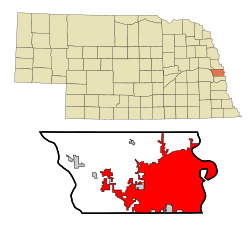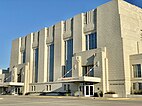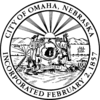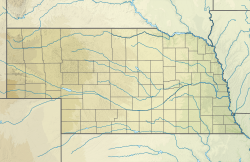
Back Omaha Afrikaans Omaha (Nebraska) AN Ōmahha ANG أوماها (نبراسكا) Arabic اوماها نبراسكا ARZ Omaha (Nebraska) AST Omaha Azerbaijani اوماها AZB Омаха Byelorussian Омага BE-X-OLD
Omaha, Nebraska | |
|---|---|
| Nickname(s): Gate-city of the West,[1] The Big O | |
| Motto(s): | |
 Location within Douglas County | |
| Coordinates: 41°15′31″N 95°56′15″W / 41.25861°N 95.93750°W | |
| Country | |
| State | |
| County | Douglas |
| Founded | 1854 |
| Incorporated | 1857 |
| Named for | Omaha people |
| Government | |
| • Type | Strong mayor–council |
| • Mayor | Jean Stothert (R) |
| • City Clerk | Elizabeth Butler |
| • City Council | Members list |
| Area | |
| • City | 146.28 sq mi (378.85 km2) |
| • Land | 142.67 sq mi (369.51 km2) |
| • Water | 3.61 sq mi (9.35 km2) |
| Elevation | 1,060 ft (320 m) |
| Population (2020) | |
| • City | 486,051 |
| • Estimate (2021) | 487,300 |
| • Rank | 40th in the United States 1st in Nebraska |
| • Density | 3,658.41/sq mi (1,315.40/km2) |
| • Urban | 819,508 (US: 55th) |
| • Urban density | 3,026.1/sq mi (1,168.4/km2) |
| • Metro | 967,604 (US: 58th) |
| Demonym | Omahan |
| Time zone | UTC−06:00 (CST) |
| • Summer (DST) | UTC−05:00 (CDT) |
| ZIP Codes | 68022, 68101–68164 |
| Area code | 402 and 531 |
| FIPS code | 31-37000 |
| GNIS feature ID | 0835483[3] |
| Website | cityofomaha.org |
Omaha (/ˈoʊməhɑː/ OH-mə-hah) is the most populous city in the U.S. state of Nebraska and the county seat of Douglas County.[5] It is in located in the Midwestern United States along the Missouri River, about 10 mi (15 km) north of the mouth of the Platte River. The nation's 40th-most populous city, Omaha had a population of 486,051 as of the 2020 census.[6] It is the anchor of the eight-county Omaha–Council Bluffs metropolitan area, which extends into Iowa and is the 58th-largest metro area in the United States, with a population of 967,604.[4] Furthermore, the greater Omaha–Council Bluffs–Fremont combined statistical area had 1,004,771 residents in 2020.[7] Omaha is ranked as a global city by the Globalization and World Cities Research Network, which in 2020 gave it "sufficiency" status.[8]
Omaha's pioneer period began in 1854, when the city was founded by speculators from neighboring Council Bluffs, Iowa. The city was founded along the Missouri River, and a crossing called Lone Tree Ferry earned the city its nickname, the "Gateway to the West". Omaha introduced this new West to the world in 1898, when it played host to the World's Fair, dubbed the Trans-Mississippi Exposition. During the 19th century, Omaha's central location in the United States spurred the city to become an important national transportation hub. Throughout the rest of the 19th century, the transportation and jobbing sectors were important in the city, along with its railroads and breweries. In the 20th century, the Omaha Stockyards, once the world's largest, and its meatpacking plants gained international prominence.
Omaha is the home to the headquarters of four Fortune 500 companies: Berkshire Hathaway, Kiewit Corporation, Mutual of Omaha, and Union Pacific Corporation.[9] Other companies headquartered in the city include First National Bank of Omaha, Gallup, Inc., Green Plains, Intrado, Valmont Industries, Werner Enterprises, and three of the nation's ten largest architecture and engineering firms (DLR Group, HDR, Inc., and Leo A Daly).[10] Notable cultural institutions include the Henry Doorly Zoo and Aquarium, Old Market, Durham Museum, Lauritzen Gardens, and annual College World Series. Modern Omaha inventions include the Reuben sandwich;[11] cake mix, developed by Duncan Hines; center-pivot irrigation;[12] Raisin Bran; the first ski lift in the U.S.;[13] the Top 40 radio format as first used in the U.S. at Omaha's KOWH Radio; and the TV dinner.[14]
- ^ Mullens, P.A. (1901) Biographical Sketches of Edward Creighton and John A. Creighton. Creighton University. p. 24.
- ^ "ArcGIS REST Services Directory". United States Census Bureau. Archived from the original on January 19, 2022. Retrieved September 18, 2022.
- ^ a b U.S. Geological Survey Geographic Names Information System: Omaha, Nebraska
- ^ a b "2020 Population and Housing State Data". United States Census Bureau. Archived from the original on August 24, 2021. Retrieved August 22, 2021.
- ^ "Find a County". National Association of Counties. Archived from the original on May 31, 2011. Retrieved June 7, 2011.
- ^ "QuickFacts: Omaha city, Nebraska". United States Census Bureau. Archived from the original on July 8, 2022. Retrieved August 27, 2021.
- ^ "Table 1. Annual Estimates of the Population of Combined Statistical Ar/s: April 1, 2010 to July 1, 2017 (CBSA-EST2012-02)" (CSV). 2017 Population Estimates. United States Census Bureau, Population Division. July 1, 2017. Archived from the original on July 9, 2021. Retrieved January 9, 2019.
- ^ "GaWC - Data Set 11". Lboro.ac.uk. Archived from the original on December 28, 2021. Retrieved December 28, 2021.
- ^ Boettcher, Ross. "Mutual returns to Fortune 500". Omaha World-Herald. April 16, 2010. Retrieved April 28, 2010.
- ^ Cite error: The named reference
BDC 2010was invoked but never defined (see the help page). - ^ "The Reuben sandwich Reuben himself would love". Omaha.com. January 27, 2012. Archived from the original on July 14, 2012. Retrieved June 30, 2012.
- ^ "Robert Daugherty and Valmont Center Pivot Irrigation". Livinghistoryfarm.org. Archived from the original on April 26, 2012. Retrieved June 30, 2012.
- ^ "Union Pacific Invented First Ski Lift In Omaha". Wowt.com. November 29, 2010. Archived from the original on February 9, 2013. Retrieved June 30, 2012.
- ^ "Omaha Innovators Swanson". Omahahistory.org. Archived from the original on February 26, 2012. Retrieved June 30, 2012.
© MMXXIII Rich X Search. We shall prevail. All rights reserved. Rich X Search










